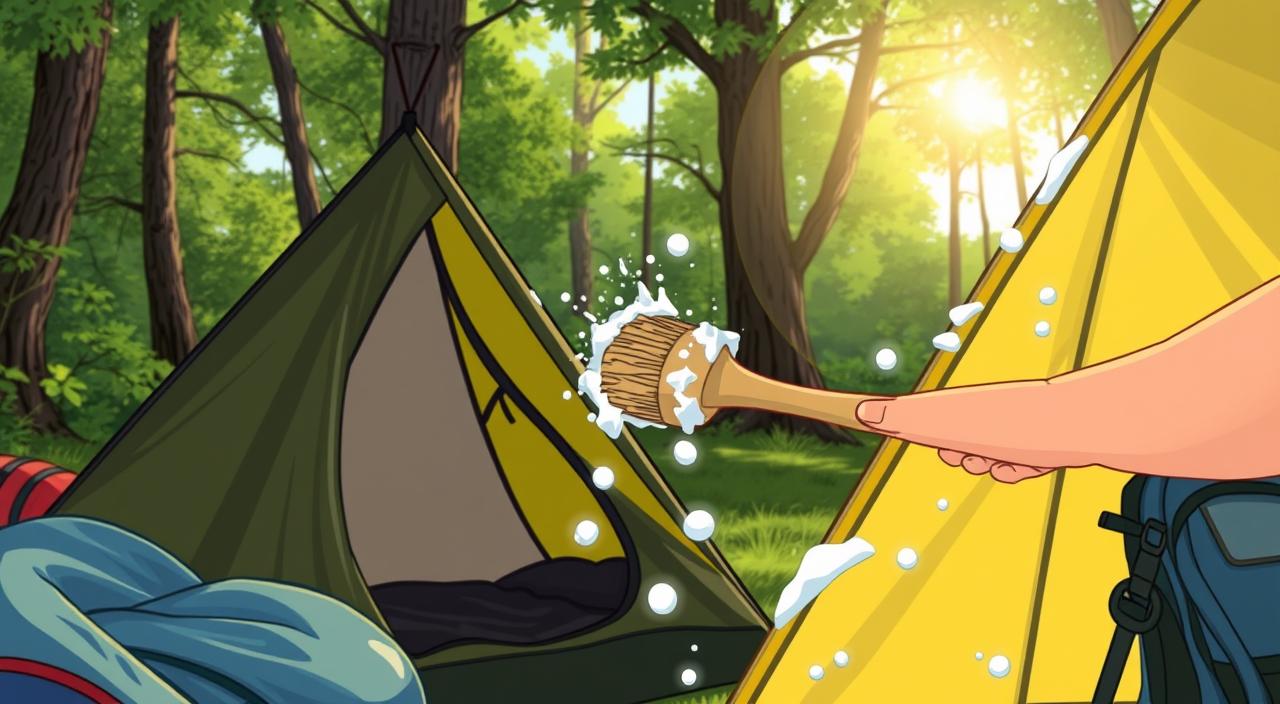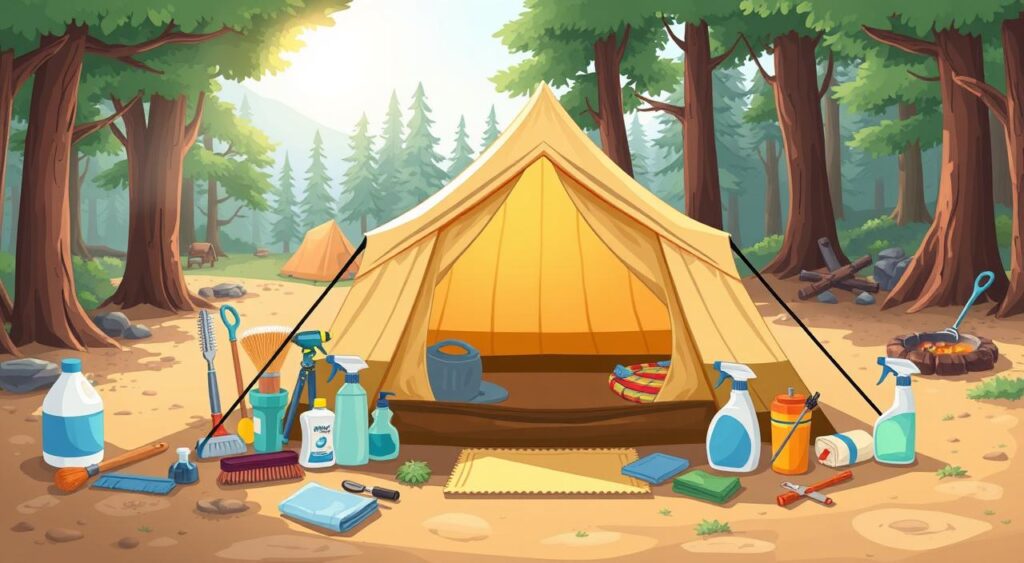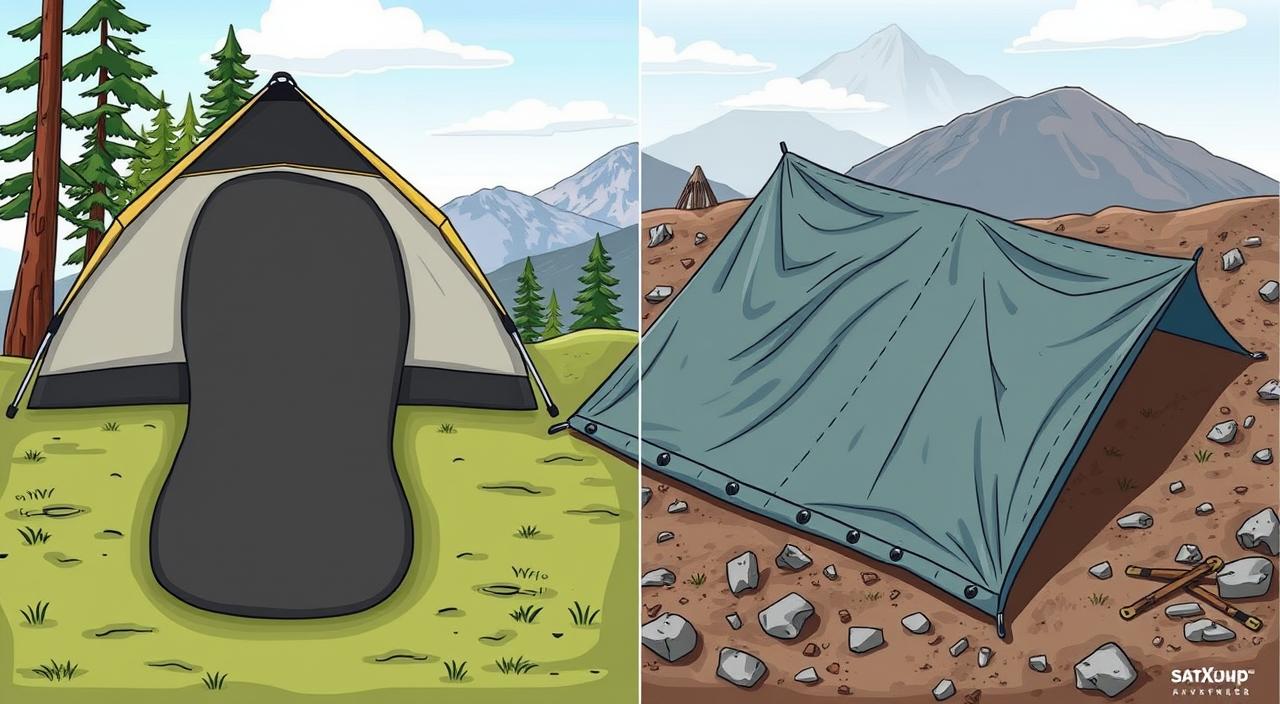
Disclaimer: This post may contain affiliate links. As an Amazon Associate, we earn from qualifying purchases.
Ever wonder how a bit of moisture can turn your camping tent into a mold haven? For all outdoor lovers, it’s crucial to know how to clean a tent with mold. Mold can grow fast in damp conditions, making your tent less durable and harmful to your health. We’ll show you how to clean your moldy tent safely so you can enjoy camping without worries.
Key Takeaways
- Cleaning your tent can take about 30 minutes, and it should air dry for 6-8 hours.
- For effective cleaning, mix 2 fl oz of Revivex Pro Cleaner with 1 fl oz of Revivex Odor Eliminator per gallon of water.
- Soak your tent in the Odor Eliminator mix for no more than 5 minutes to protect the PU coating.
- Regular cleaning and proper storage can stop mold and mildew from growing.
- Watch out for mold in different colors; spotting it early helps protect your tent and health.
Understanding Mold in Tents
Mold is a common problem for tent owners if they don’t take good care. Knowing the causes of mold growth and spotting the signs of tent mold helps you act fast. Mold loves moist, dark, and warm places, which tents often have. Keeping up with outdoor gear mold prevention is key to keeping your camping stuff safe and sound.
What Causes Mold to Grow?
Here are the main reasons mold grows:
- Prolonged exposure to wetness
- Lack of ventilation
- Storage in shaded or damp areas
- High humidity and temperature changes
Even a little moisture can make a great home for mold spores. In just 24 hours, mold can start to grow if it’s the right conditions.
Recognizing Signs of Mold in Your Tent
Spotting mold early can save you a lot of work in cleaning. Look for these signs of tent mold:
- Visible dark spots or patches
- Foul or musty smells
- Deteriorating fabric or trail marks on the tent
If you ignore these signs, your tent could get worse, leading to rot and holes. Catching it early means you can clean and fix it. Regular checks help keep your tent in good shape.
| Condition | Consequence |
|---|---|
| High Moisture | Mold growth within 24 hours |
| Poor Ventilation | Increased mold spread |
| Shaded Storage | Prolonged wetness |
| Humidity Fluctuations | Fabric deterioration |
Health Risks Associated With Tent Mold
Mold in your tent can be harmful to anyone who touches it. It’s important to know how mold can affect your health for a safe camping trip. Mold loves damp, dark, and poorly aired places, making tents perfect for it. It’s not just ugly; it can cause serious health problems.
Health Effects of Mold Exposure
People react differently to mold, especially if they already have health issues. Common problems include:
- Respiratory issues like coughing, wheezing, and trouble breathing
- Skin irritation and rashes
- Allergic reactions, causing sneezing, stuffy nose, and itchy eyes
Black mold is especially dangerous for those with allergies, asthma, or young kids. Long-term exposure can cause serious health problems. This shows why it’s vital to deal with mold fast.
Why You Shouldn’t Sleep in a Moldy Tent
Sleeping in a moldy tent can make health problems worse, especially for sensitive people. The close space means you’re more likely to breathe in mold spores at night. This can make breathing harder and worsen respiratory issues.
To keep your health safe, you must remove mold right away. Check your tent often and take steps to prevent mold to ensure a safe outdoor trip.
Cleaning a tent with mold needs a detailed and effective process. This guide will show you how to make your tent look new again. It covers using vinegar for cleaning and other methods to remove mold.
Step-by-Step Cleaning Process
Start with these steps to clean a tent with mold:
- Take the tent out of storage and set it up outside if you can.
- Use a soft brush to remove any loose dirt or debris.
- Make a cleaning solution. For a natural option, mix equal parts water and vinegar in a spray bottle. For a stronger solution, use 2 fl oz of Revivex Pro Cleaner with water.
- Put the cleaning solution on moldy spots and wait for about 10 minutes.
- Scrub the moldy areas with a soft brush. Be careful with any deep stains.
- Rinse the tent well with clean water to remove all cleaning solutions. This helps prevent residue buildup.
- Let the tent air dry for 6-8 hours in a place with good airflow, away from direct sunlight.
Using Bleach or Vinegar for Cleanup
Vinegar is a great choice for cleaning mold. Mix one part vinegar with three parts water for a safe solution. If the mold is tough, a diluted bleach solution (1 cup of bleach in a gallon of water) can be used. Always:
- Wear gloves and eye protection when using bleach.
- Make sure you’re in a well-ventilated area to avoid inhaling fumes.
- Test the solution on a small, hidden part of the tent first to avoid color changes.
After cleaning, think about using waterproofing sprays to protect your tent. Regular care and prevention will help your canvas tent last a long time.
| Task | Time Required |
|---|---|
| Cleaning Process | 30 minutes |
| Air Drying | 6-8 hours |
| Deodorizing | 30 minutes |
| Treating PU Odors | 3 hours |
| Air Drying After Treating PU Odors | 24 hours |
Additional Tent Cleaning Tips
Cleaning your tent is key to keeping it in good shape, especially when it gets moldy. Besides the deep cleaning methods we talked about, there are some tent cleaning tips for dealing with mold in specific spots. This part will cover how to clean spots and avoid damage while doing it.
Spot Cleaning Techniques
Spot cleaning works well for small mold patches on your tent. Start by gently scrubbing these spots with a soft brush or cloth. A mix of distilled white vinegar and water is great for cleaning moldy camping gear, especially on canvas tents. Here’s a simple recipe:
- 1 part distilled white vinegar
- 3 parts water
- Add salt or lemon juice for extra power
Put the mix on the moldy spot and let it sit for 10-15 minutes. Then, rinse it well with clean water and let it dry in the air. Remember, mold stains on canvas can be hard to remove, so you might need to clean it a few times to get it right.
Preventing Damage During Cleaning
Being careful while cleaning is crucial to preventing tent damage. Always use cleaners that are safe and avoid harsh chemicals that could harm the tent’s materials or waterproof layer. For hard stains, think about using a special cleaner like Revivex Pro Cleaner (start with 2 fl oz). Here are some ways to keep your gear safe:
- Test any cleaner on a small, hidden spot first.
- Use a soft brush to avoid scratches or damage.
- Avoid soaking the tent; too much water can cause mold to come back.
After cleaning, make sure your tent is completely dry before storing it to avoid mold later. Stick to these tent cleaning tips and your camping gear will stay in top shape for many trips ahead.

| Activity | Estimated Time |
|---|---|
| Cleaning | 30 minutes |
| Air Drying | 6-8 hours |
| Deodorizing | 30 minutes |
| Treatment for PU Odors | 3 hours |
| Air Drying After Treatment | 24 hours |
Deodorizing Your Tent After Cleaning
After cleaning your tent, it’s key to get rid of any mold smells. There are several ways to make sure your tent smells fresh for your next trip.
Natural Deodorizing Solutions
Natural ways to deodorize your tent are great for keeping it fresh. Ingredients like baking soda and vinegar work well. Here’s a simple way to do it:
- Sprinkle baking soda inside the tent, focusing on areas that may retain odors.
- Mix equal parts of water and vinegar in a spray bottle, lightly mist the tent’s interior to neutralize smells.
- Allow the tent to air dry completely for optimal results.
Using Specialized Odor Eliminators
For strong smells, try specialized odor eliminators like Revivex Odor Eliminator. It’s safe for tent fabrics and targets tough smells. Here’s how to use it:
- Add 1 fluid ounce (29.6 ml) of Revivex Odor Eliminator to each gallon of warm water.
- Soak the tent in this mixture for no longer than 5 minutes to effectively saturate it with odor-fighting microbes.
- Once treated, air dry the tent for a minimum of 6 to 8 hours to allow the deodorizing agents to work effectively.
If your tent has old PU coating and smells bad, you might need to soak it for 2 to 3 hours. Then, reapply a PU coating to get rid of the smell.
| Deodorizing Method | Recommended Actions | Estimated Time |
|---|---|---|
| Natural Solutions | Baking soda application, vinegar spray | Air Dry – 6 to 8 hours |
| Specialized Odor Eliminators | Mix solution and soak tent | Washing – 30 minutes, Soaking – 5 minutes |
| PU Coating Reapplication | Soak and apply coating | Treatment – 3 hours, Air Dry – 24 hours |
Preventing Mold Growth in the Future
To keep your tent mold-free, you need to act early. Focus on preventing future mold growth. Learn the right ways to store your gear and keep up with regular maintenance. This will help keep your camping equipment in great shape.
Proper Tent Storage Methods
Always make sure your tent is dry before you fold it up. A damp tent is a perfect spot for mold to grow. Use bags or covers that let air in to store your tent. Keep it in a cool, dry spot out of the sun to keep humidity low.
Best Practices for Tent Maintenance
Good tent maintenance practices can make your gear last longer. Check your tent often for leaks or damage that could let mold in. Clean your tent right after each use, especially if it got wet or had food on it. Use UV protectants to protect your tent from the sun.
Make sure your tent has good airflow and stays dry. This keeps it smelling fresh and mold-free.

Choosing the Right Cleaning Products
When you’re keeping your tent in top shape, choosing cleaning products that match the fabric is key. The right cleaners keep your gear strong and clean, removing mold and dirt well. Products like Revivex are made just for tents and work safely and effectively. They help get rid of tough stains and keep your tent waterproof, which is crucial for camping.
Recommended Cleaners for Tent Fabrics
Your tent’s fabric needs special care to last longer. Pick cleaners made for outdoor use. Here are some top picks:
These cleaners clean well without harming your tent’s function. For more tips on tent cleaning, check out this resource.
Importance of Non-Toxic Options
Choosing non-toxic tent cleaners is good for your health and the planet. These cleaners are safer for you and the environment. Going for safe tent cleaning solutions keeps you and nature healthy.
| Product | Non-Toxic | Water Repellency Preserved |
|---|---|---|
| Revivex Tent Cleaner | Yes | Yes |
| Granger’s Performance Wash | Yes | Yes |
| Nikwax Tech Wash | Yes | Yes |
| Star Brite Tent Cleaner | No | No |
Knowing your options and using non-toxic tent cleaners makes camping fun and safe. These choices are good for your gear and the earth. Enjoy the outdoors with peace of mind.
Storing Your Tent Properly
Storing your tent right is key to making it last longer and avoiding mold and mildew. Using air drying techniques helps keep moisture out of your tent fabric. This is important for keeping your tent strong and waterproof. Here are some steps to follow for proper tent storage.
How to Air Dry Your Tent
Before you store your tent, make sure it’s completely dry. Here’s how to air dry it:
- Set up the tent in a place with good airflow, outside if you can, away from the sun.
- Turn the tent inside out to dry both sides well.
- Leave the tent out for 6-8 hours to let it fully air out.
Finding Ideal Storage Conditions
After drying your tent, store it in the best conditions. Keep these tips in mind:
- Put the tent in a cool, dry spot to stop moisture from building up and causing mildew.
- Don’t store it where the temperature and humidity change a lot, as this can harm the tent’s materials.
- Check the storage area often for dirt or dust, which can make mold grow if the tent isn’t cleaned well after use.
Looking after your tent well can make it last a long time. Clean your tent after every trip to fight moisture and keep it in great shape. Good practices include drying it properly and storing it in the right conditions. For more tips on cleaning and getting rid of odors, check out this detailed guide on tent care.

Common Myths About Tent Mold
There are many wrong ideas about tent mold that can lead to bad cleaning results and ongoing issues. It’s key to debunk these myths to keep your camping gear in good shape and ensure a safe place. Knowing the truth about mold cleanup and waterproof coatings will help you take better care of your tent.
Misconceptions About Mold Cleanup
Many think bleach is the best way to deal with mold. But bleach can harm tent fabrics and weaken waterproof coatings. Instead, try using Gear Aid Revivex Odor Eliminator. It cleans and gets rid of mildew smells without the risks.
- Mold can grow on various tent fabrics, including canvas and polyester.
- Minor mold issues don’t always need big fixes; simple cleaning works.
- Insurance often doesn’t cover mold and similar damages.
Understanding Your Tent’s Waterproof Coating
Some believe waterproof coatings stop all mold growth. They do keep moisture out, but not storing or drying your tent right can cause mold. It’s important to know how your tent’s coating works. Keeping it clean and maintained can make it last longer and reduce mold risk.
| Myth | Truth |
|---|---|
| Bleach is the best mold remover. | Bleach can damage tent fabrics and reduce waterproofing. |
| All tents are fully protected against mold. | Waterproof coatings help, but moisture must be managed. |
| Mold cleanup always requires expensive services. | Small mold patches can often be cleaned within a budget. |
| Mold testing is a necessity. | The EPA advises against it due to inconsistent results. |
Getting rid of these tent mold myths can make your camping trips better. Stay informed and act early to have mold-free adventures!
Conclusion
Learning how to clean moldy tents is key for outdoor lovers. Mold and mildew can show up in just 24 to 48 hours on wet surfaces. So, it’s important to clean and maintain your tent well.
This keeps your camping trips safer and more fun. It also helps keep you healthy. By using the right cleaning methods and products, you can enjoy the outdoors more.
Keeping your tent mold-free is good for more than just your health. A clean tent also makes your outdoor adventures better. By using good ventilation, checking your tent often, and cleaning with the right stuff, you can stop mold before it starts.
Follow these cleaning tips for a healthier camping spot. Always check for damp spots and use safe cleaners to keep mold away. Choosing a strong, well-made tent, like those from Glitzcamp, can make your outdoor trips better. It also lowers the chance of mold problems.








